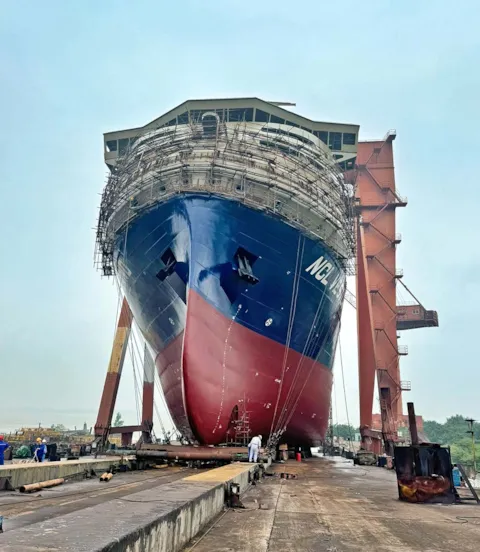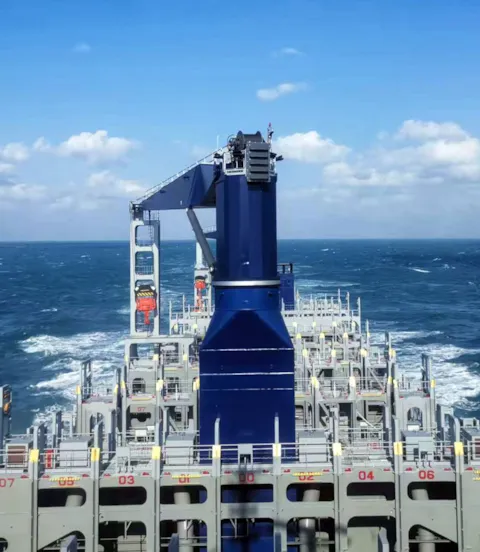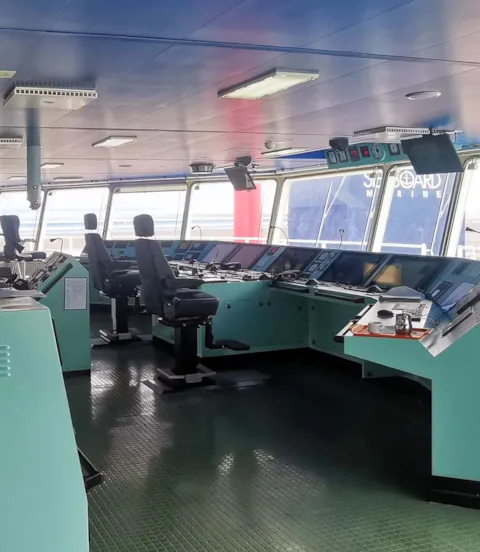Sanfu Shipyard delivers advanced methanol-powered container feeders to MPC
In a groundbreaking project, Sanfu Shipyard in China delivered two state-of-the-art, methanol dual-fuel container feeder vessels to the owner MPC Container Ships and long-term charterer North Sea Container Line. The vessels mark the launch of a green corridor across the North Sea.
The NCL Vestland and the NCL Nordland are two identical sister ships delivered in February and April 2025 respectively. Built to DNV class by Taizhou Sanfu Ship Engineering Co., Ltd. in China, the 1300-TEU methanol dual-fuel container feeders are designed to open a new chapter in northern European coastal shipping. Both the Norwegian owner, MPC Container Ships ASA (MPCC), and the long-term charterer, North Sea Container Line (NCL), are striving to establish a ‘green corridor’ for container shipping between Norway and the Dutch and German North Sea ports by building up a fleet of carbon-neutral vessels. Constantin Baack, CEO of the owner MPCC, stated: “These innovative feeder vessels demarcate the next step of MPC Container Ships’ decarbonization strategy. Both vessels will be able to operate on ‘green’ methanol from day one. With more dual-fuel vessels to come, they will play a central role in our ongoing fleet renewal and emissions reduction efforts, positioning MPCC as a fuel-agnostic early mover and knowledge partner in fostering a more sustainable shipping industry.”
Designed for carbon-neutral operation, flexibility and safety
These are the first containerships designed to operate on eco-friendly methanol fuel, featuring advanced innovations that make them pioneers in sustainable shipping and highly flexible for cargo stowage. The methanol system, supplied by Qingdao Sunrui, underwent thorough scrutiny by DNV to ensure safety and reliability. “The two vessels are equipped with the safest methanol fuel system design and most rational layout to date,” says Øyvind Pettersen, head of the DNV Technical Center China (TCC).

Collaboration enables a milestone in green shipping
For the owner MPCC, this was the first collaboration with DNV in China and Sanfu Shipyards. “At the beginning of the project, the shipowner had reservations about placing such a high-end vessel design with Sanfu Shipyard,” says says Aakash Dua, Regional Business Development Manager at DNV West Europe. “However, through close collaboration with our team in China, the shipyard and the owner, we overcame all challenges. Ultimately, the owner is very pleased with the vessels and their performance.”
DNV ensured adherence to rigorous quality and safety standards at the yard, and Sanfu made a point of prioritizing risk assessments and compliance with DNV’s Risk-Based Ship Design. For example, the yard placed great emphasis on enhancing battery safety and methanol system reliability.
“These vessels stand as a milestone in green shipping and collaborative innovation,” says Yifeng Yang, Chairman of Sanfu Shipyard. “They embody the synergy of international expertise and economic globalization, setting a benchmark for the maritime industry’s sustainable future. The successful delivery of these high-end methanol-powered container feeders owes much to DNV’s unwavering commitment to safety, quality and environmental excellence. The technical manager Wilhelmsen Ahrenkiel Ship Management and DNV China provided exceptional expertise in ship design, plan approval and construction supervision, which were instrumental in achieving the successful delivery of these two carbon-neutral vessels.”

Optimizing CII carbon intensity ratings
MPCC and NCL have prioritized meeting 2050 emission standards today in the design of these vessels. They decided to incorporate cutting-edge, real-time reefer container monitoring systems to optimize CII carbon intensity ratings and enhance operational efficiency. Each ship can accommodate up to 380 power-hungry reefer containers.
Further features maximizing energy efficiency and minimizing the environmental footprint include a containerized, maintenance-friendly shore power system from Zhenjiang SaierNico that eliminates emissions at berth and helps keep port stays short. Additionally, the vessels feature a shore-charged battery system and an advanced energy management system with power take-home (PTH) functionality, providing backup power for the hybrid propulsion system and ensuring stable grid supply during manoeuvres. While at sea, the battery system is charged by a permanent-magnet shaft generator.

Waste heat recovery and hydrodynamic optimization
Apart from the streamlined hull design, the vessels’ optimized hydrodynamic properties include a controllable-pitch propeller, a twisted flap rudder and a rudder ball. The aerodynamic bow design reduces drag.
Furthermore, a waste heat recovery system uses engine heat instead of boilers as a heat source, further reducing fuel consumption. Exhaust gas recirculation (EGR) technology cuts NOx emissions and fuel consumption by an additional 1 to 2.5 per cent. Both ships’ EEDI (14.837 g CO2/ton-nm) surpasses Phase III requirements.

Excellent manoeuvrability
Built to be deployed in sub-arctic waters, the NCL Nordland and the NCL Vestland both have DNV ice class. With the deckhouse right at the bow, the vessels have unobstructed visibility even when carrying the maximum number of containers. DNV’s Linsheng Xu, project manager at Sanfu Shipyard, emphasizes the navigational agility of the vessels: “They are equipped with intelligent navigation assistance and have enhanced handling properties, achieving the highest manoeuvrability rating for single-person bridge operation.” A transition from half-speed forward (8.8 knots) to full reverse can be accomplished in just 160 seconds. DNV’s highest bridge class notation, NAUT(AW), confirms that the ships can navigate safely through narrow coastal routes, including the Norwegian fjords. The bow and stern thrusters, which are powered by DC hub drives, further enhance manoeuvrability and ensure seamless docking.

Flexible cargo carrying capability
With a total container capacity exceeding that of other vessels currently operating on the same feeder routes by around 40 per cent, the two ships represent a significant boost to charterer NCL’s transport capabilities. Ready to carry not only refrigerated, but also IMDG-compliant hazardous cargo, both are equipped with two 45-tonne cranes each, enhancing NCL’s operating efficiency by allowing discharging and loading at ports without land-based infrastructure. Flexibility was at the top of the shipbuilders’ agenda when they developed a mobile cell guide system that can be arranged for mixed container loads, boosting cargo flexibility and efficiency. The cargo holds are hatchless to allow for fast loading and discharging at multiple ports in succession, reducing berthing times.

Getting serious about sustainable shipping
As an early mover, NCL is currently replacing its fleet of older, conventionally-powered tonnage with state-of-the-art, carbon-neutral ships and will also be operating the world’s first ammonia-powered container vessel, the Yara Eyde, scheduled to launch in 2026. Bio-methanol for the NCL Vestland and the NCL Nordland is being sourced in Norway.
According to CEO Bente Hetland, the delivery of these two methanol-powered, next-generation vessels significantly advances NCL’s goal of reducing CO2 emissions by 80% by 2030. “We are proud to take the lead in the transition of making sea freight greener, safer and more reliable for the Norwegian coastline. These cutting-edge vessels are symbols of innovation and demonstrate what can be achieved if the right partners collaborate.”
- Sanfu Shipyard
